Exploring the Relationship between Top Management Team Characteristics and Corporate Social Responsibility: A Literature Review and Bibliometric Analysis
Abstract
1. Introduction
2. Research Method
3. Bibliometric Analysis
3.1. Informative Evaluation of Yearly Publications
3.2. Country Distribution of Publications
3.3. Countries Network
3.4. Sankey Schematics
3.5. Co-Occurrence Network of Keywords
4. Full-Text Analysis
5. Discussion
6. Conclusions
7. Future Research Directions with Limitations
Author Contributions
Funding
Institutional Review Board Statement
Informed Consent Statement
Data Availability Statement
Conflicts of Interest
References
- Hambrick, D.C.; Mason, P.A. Upper Echelons: The Organization as a Reflection of Its Top Managers. Acad. Manag. Rev. 1984, 9, 193. [Google Scholar] [CrossRef]
- Aboramadan, M. Top Management Teams Characteristics and Firms Performance: Literature Review and Avenues for Future Research. Int. J. Organ. Anal. 2021, 29, 603–628. [Google Scholar] [CrossRef]
- Chen, Y.; Ge, Y.; Song, Z. Power Perspective: A New Framework for Top Management Team Theory. iBusiness 2010, 2, 274–281. [Google Scholar] [CrossRef][Green Version]
- Gu, J. Firm Performance and Corporate Social Responsibility: Spatial Context and Effect Mechanism. SAGE Open 2023, 13, 215824402311521. [Google Scholar] [CrossRef]
- Li, X.; Kim, J.-B.; Wu, H.; Yu, Y. Corporate Social Responsibility and Financial Fraud: The Moderating Effects of Governance and Religiosity. J. Bus. Ethics 2021, 170, 557–576. [Google Scholar] [CrossRef]
- Huang, J.; Duan, Z.; Hu, M.; Li, Y. More Stable, More Sustainable: Does TMT Stability Affect Sustainable Corporate Social Responsibility? Emerg. Mark. Financ. Trade 2022, 58, 921–938. [Google Scholar] [CrossRef]
- George, S.; Forret, M.L. TMT Commitment to Corporate Social Responsibility: How It Relates to Employee Engagement. Acad. Manag. Proc. 2015, 2015, 13772. [Google Scholar] [CrossRef]
- Liu, D.; Zhou, Z.; Zhao, Q.; Li, D. Top Management Team Cognitive Heterogeneity and Corporate Social Responsibility Performance. Int. J. Econ. Financ. 2024, 16, 1. [Google Scholar] [CrossRef]
- Hąbek, P.; Wolniak, R. Relationship between Management Practices and Quality of CSR Reports. Procedia Soc. Behav. Sci. 2016, 220, 115–123. [Google Scholar] [CrossRef]
- Alavi, H.; Habek, P.; Cierna, H. Corporate Social Responsibility and Self-Regulation. MM Sci. J. 2016, 2016, 1121–1126. [Google Scholar] [CrossRef]
- Orbik, Z.; Zozuľaková, V. Corporate Social and Digital Responsibility. Manag. Syst. Prod. Eng. 2019, 27, 79–83. [Google Scholar] [CrossRef]
- Sütőová, A.; Kóča, F. Corporate Social Responsibility Standards: Is It Possible to Meet Diverse Customer Requirements? Manag. Syst. Prod. Eng. 2022, 30, 54–61. [Google Scholar] [CrossRef]
- Latapí Agudelo, M.A.; Jóhannsdóttir, L.; Davídsdóttir, B. A Literature Review of the History and Evolution of Corporate Social Responsibility. Int. J. Corp. Soc. Responsib. 2019, 4, 1. [Google Scholar] [CrossRef]
- Zhao, L.; Yang, M.M.; Wang, Z.; Michelson, G. Trends in the Dynamic Evolution of Corporate Social Responsibility and Leadership: A Literature Review and Bibliometric Analysis. J. Bus. Ethics 2023, 182, 135–157. [Google Scholar] [CrossRef]
- Otto, E.; Culakova, E.; Meng, S.; Zhang, Z.; Xu, H.; Mohile, S.; Flannery, M.A. Overview of Sankey Flow Diagrams: Focusing on Symptom Trajectories in Older Adults with Advanced Cancer. J. Geriatr. Oncol. 2022, 13, 742–746. [Google Scholar] [CrossRef] [PubMed]
- Shakil, M.H.; Abdul Wahab, N.S. Top Management Team Heterogeneity, Corporate Social Responsibility and Firm Risk: An Emerging Country Perspective. J. Financ. Report. Account. 2023, 21, 434–463. [Google Scholar] [CrossRef]
- Ali, M.; Grabarski, M.K.; Ahmed, S.; Imtiaz, N. Does Leadership Gender Diversity Drive Corporate Social Responsibility and Organizational Outcomes? The Role of Organization Size. Aust. J. Manag. 2024, 49, 319–339. [Google Scholar] [CrossRef]
- Li, Z.; Wang, B.; Zhou, D. Financial Experts of Top Management Teams and Corporate Social Responsibility: Evidence from China. Rev. Quant. Finan Acc. 2022, 59, 1335–1386. [Google Scholar] [CrossRef]
- Saeed, A.; Riaz, H.; Liedong, T.A.; Rajwani, T. The Impact of TMT Gender Diversity on Corporate Environmental Strategy in Emerging Economies. J. Bus. Res. 2022, 141, 536–551. [Google Scholar] [CrossRef]
- Jiang, Y.; Zhang, L.; Tarbert, H. Does Top Management Team Media Exposure Affect Corporate Social Responsibility? Front. Psychol. 2022, 13, 827346. [Google Scholar] [CrossRef]
- Sun, W.; Govind, R. A New Understanding of Marketing and “Doing Good”: Marketing’s Power in the TMT and Corporate Social Responsibility. J. Bus. Ethics 2022, 176, 89–109. [Google Scholar] [CrossRef]
- Tran, N.M.; Nguyen, T.H. Women’s Leadership and SMEs’ CSR Performance: Family versus Nonfamily Firms. Cogent Bus. Manag. 2022, 9, 2157973. [Google Scholar] [CrossRef]
- Ma, J.; Huang, X. TMT Experience and Corporate Social (Ir)Responsibility: The Moderating Effects of Faultlines. Nankai Bus. Rev. Int. 2023, 14, 675–697. [Google Scholar] [CrossRef]
- Zheng, Q.; Lin, D. Top Management Team Stability and Corporate Social Responsibility: The Moderating Effects of Performance Aspiration Gap and Organisational Slack. Sustainability 2021, 13, 13972. [Google Scholar] [CrossRef]
- Liu, W.; Ren, T.; Tang, W. Teachers in the Top Management Team and Corporate Social Responsibility. Sustainability 2021, 13, 13795. [Google Scholar] [CrossRef]
- Fehr, R.; Gupta, A.; Guarana, C. Rewarding Morality: How Corporate Social Responsibility Shapes Top Management Team Compensation Votes. Organ. Behav. Hum. Decis. Process. 2021, 167, 170–188. [Google Scholar] [CrossRef]
- Lee, T.; Liu, W.; Yu, J. Does TMT Composition Matter to Environmental Policy and Firm Performance? The Role of Organizational Slack. Corp. Soc. Responsib. Environ. 2021, 28, 196–213. [Google Scholar] [CrossRef]
- Lu, Q.; Chen, S.; Chen, P. The Relationship between Female Top Managers and Corporate Social Responsibility in China: The Moderating Role of the Marketization Level. Sustainability 2020, 12, 7730. [Google Scholar] [CrossRef]
- Kachouri, M.; Salhi, B.; Jarboui, A. The Impact of Gender Diversity on the Relationship between Managerial Entrenchment and Corporate Social Responsibility: Evidence from UK Companies. J. Glob. Responsib. 2020, 11, 197–217. [Google Scholar] [CrossRef]
- Friske, W.; Nikolov, A.N.; Hoang, P. CSR Reporting Practices: An Integrative Model and Analysis. J. Mark. Theory Pract. 2020, 28, 138–155. [Google Scholar] [CrossRef]
- Fu, R.; Tang, Y.; Chen, G. Chief Sustainability Officers and Corporate Social (Ir)Responsibility. Strateg. Manag. J. 2020, 41, 656–680. [Google Scholar] [CrossRef]
- Hu, Y.; Zhang, Q.; Wang, X. Potentials of Top Management Team Career Development and Corporate Social Responsibility: A Study on Listed Manufacturing Companies in China. Career Dev. Int. 2019, 24, 560–579. [Google Scholar] [CrossRef]
- Lee, W.S.; Moon, J. Tenure of Top Management Team, Employee Relationship, and Value of Airlines. Res. Transp. Bus. Manag. 2018, 28, 85–91. [Google Scholar] [CrossRef]
- Reimer, M.; Van Doorn, S.; Heyden, M.L.M. Unpacking Functional Experience Complementarities in Senior Leaders’ Influences on CSR Strategy: A CEO–Top Management Team Approach. J. Bus. Ethics 2018, 151, 977–995. [Google Scholar] [CrossRef]
- Liu, Y.; Gulzar, M.A.; Zhang, Z.; Yang, Q. Do Interaction and Education Moderate Top Management Team Age Heterogeneity and Corporate Social Responsibility? Soc. Behav. Personal. Int. J. 2018, 46, 2063–2079. [Google Scholar] [CrossRef]
- Wiengarten, F.; Lo, C.K.Y.; Lam, J.Y.K. How Does Sustainability Leadership Affect Firm Performance? The Choices Associated with Appointing a Chief Officer of Corporate Social Responsibility. J. Bus. Ethics 2017, 140, 477–493. [Google Scholar] [CrossRef]
- Prabowo, M.A.; Jamin, M.; Saputro, D.J.; Mufraini, A.; Agustia, D. Female Executive Officers and Corporate Social Responsibility Disclosure: Evidence from the Banking Industry in an Emerging Market. JGBA 2017, 10, 631. [Google Scholar] [CrossRef]
- Lee, W.S.; Kim, C.; Moon, J.; Yoon, H. Impact of Airline Top Management Teams on Corporate Social Responsibility. Tour. Anal. 2017, 22, 19–29. [Google Scholar] [CrossRef]
- Lau, C.; Lu, Y.; Liang, Q. Corporate Social Responsibility in China: A Corporate Governance Approach. J. Bus. Ethics 2016, 136, 73–87. [Google Scholar] [CrossRef]
- Zhu, Y. The impact of top management team process on corporate social responsibility and firm performance. Front. Bus. Res. China 2013, 7, 268–288. [Google Scholar] [CrossRef]
- Strand, R. The Chief Officer of Corporate Social Responsibility: A Study of Its Presence in Top Management Teams. J. Bus. Ethics 2013, 112, 721–734. [Google Scholar] [CrossRef]
- McGuinness, P.B.; Vieito, J.P.; Wang, M. The Role of Board Gender and Foreign Ownership in the CSR Performance of Chinese Listed Firms. J. Corp. Financ. 2017, 42, 75–99. [Google Scholar] [CrossRef]


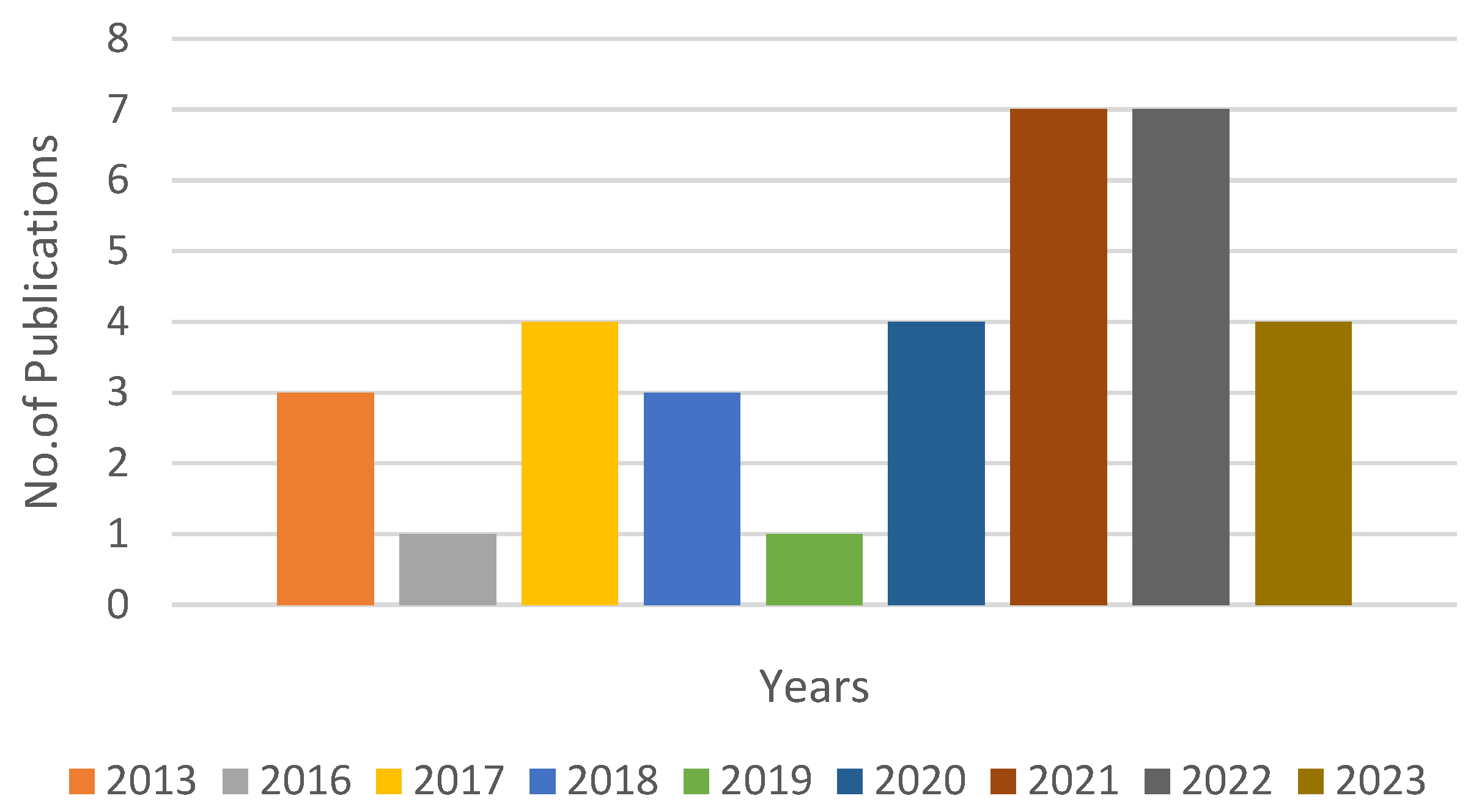
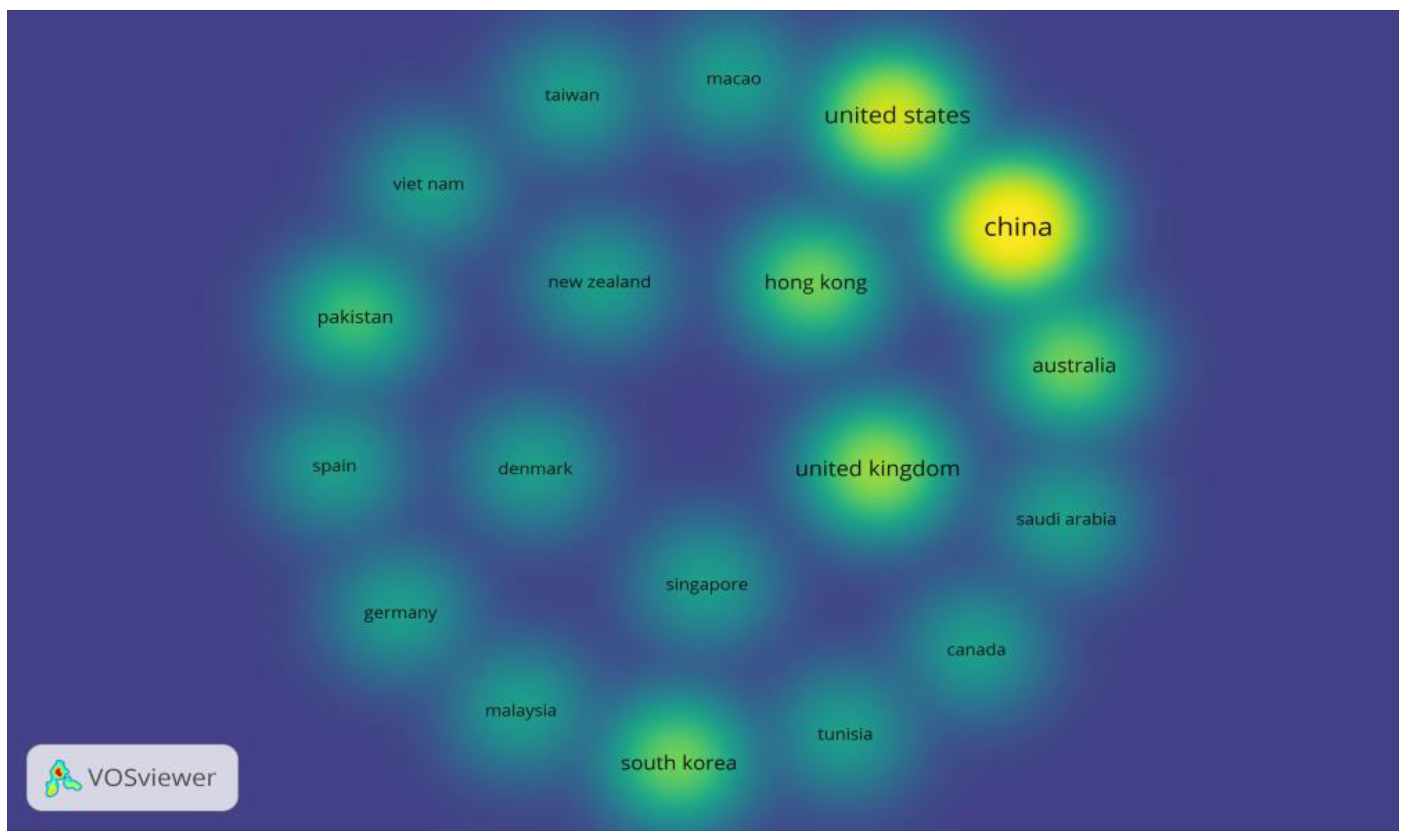
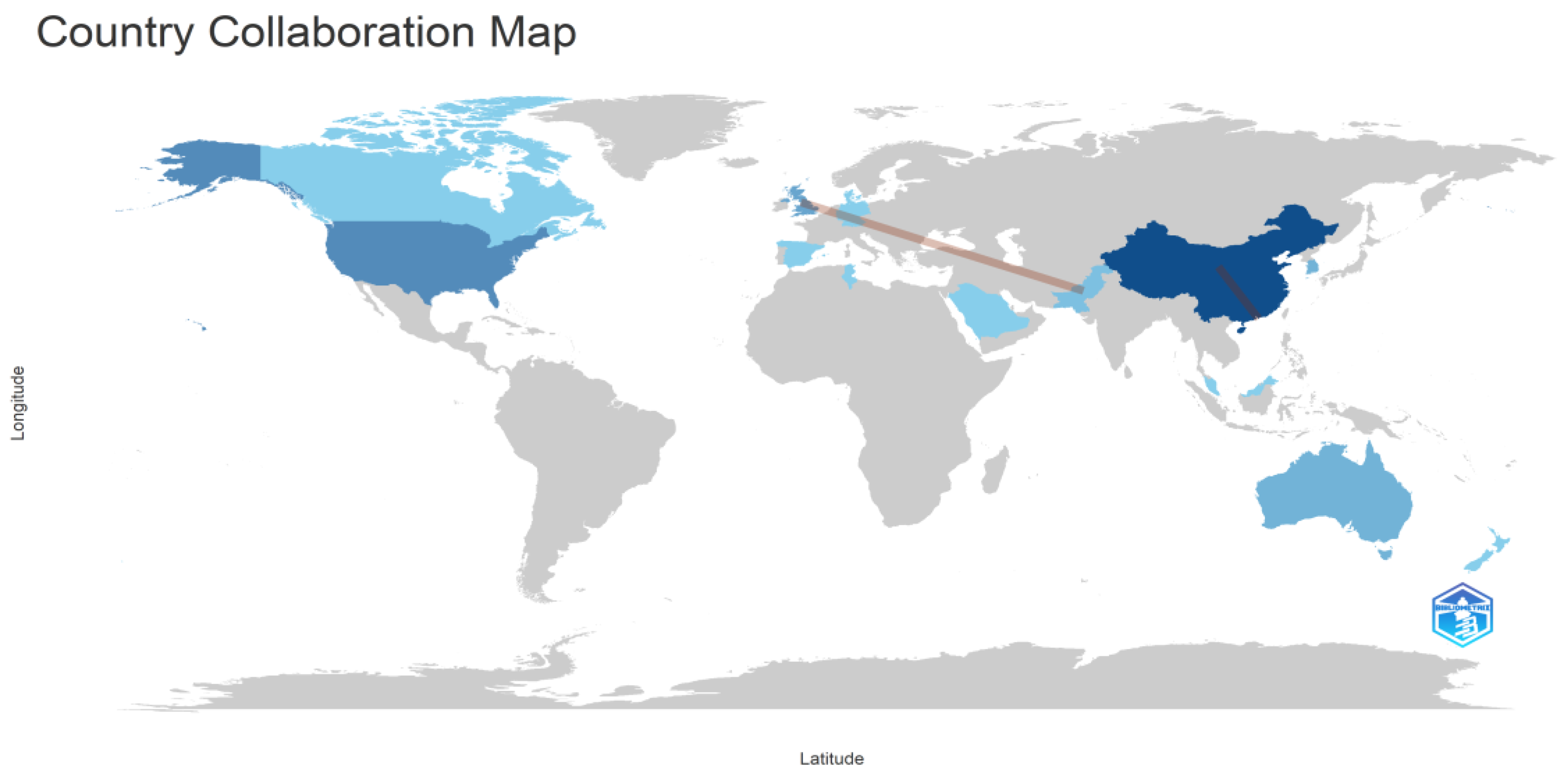
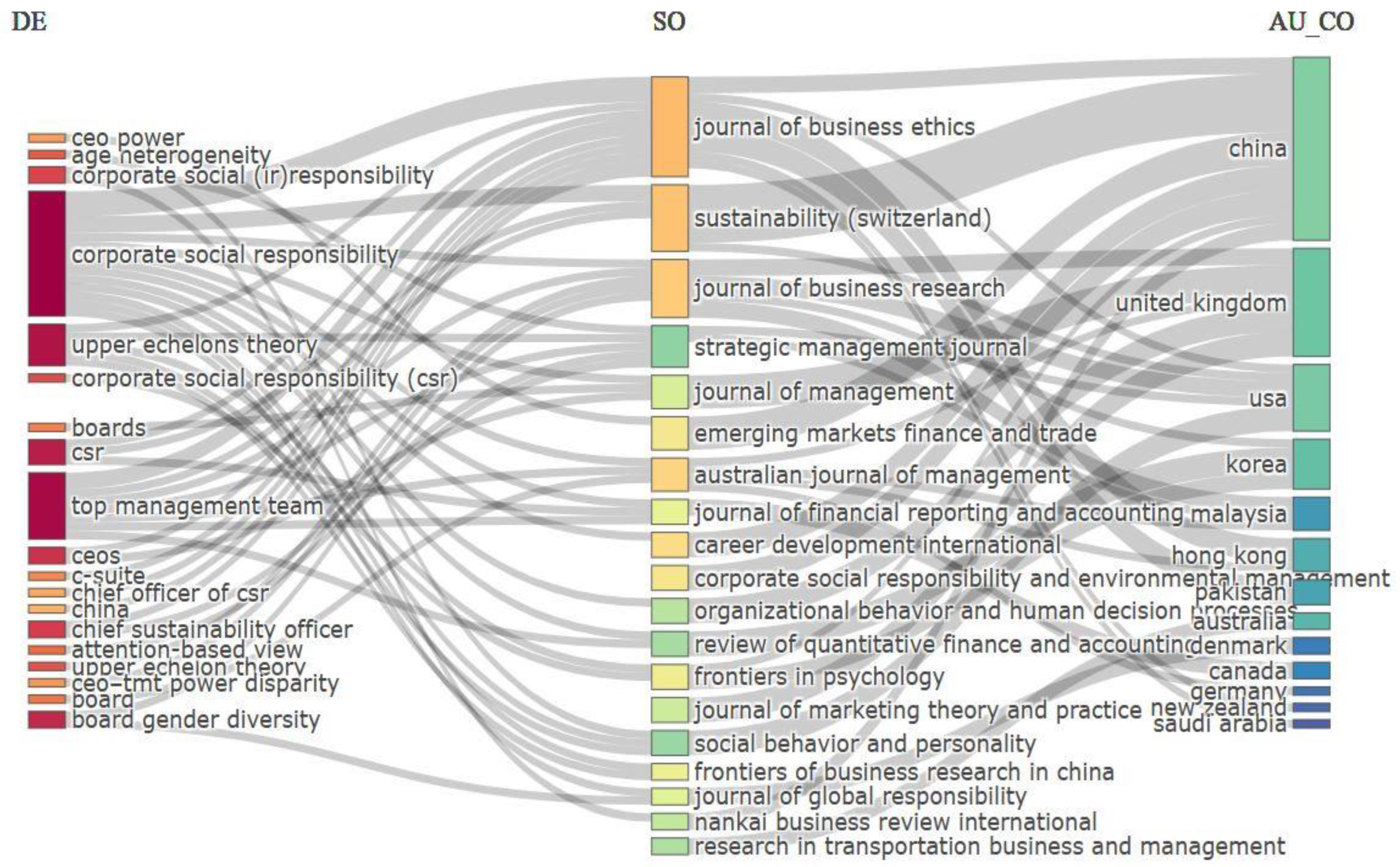
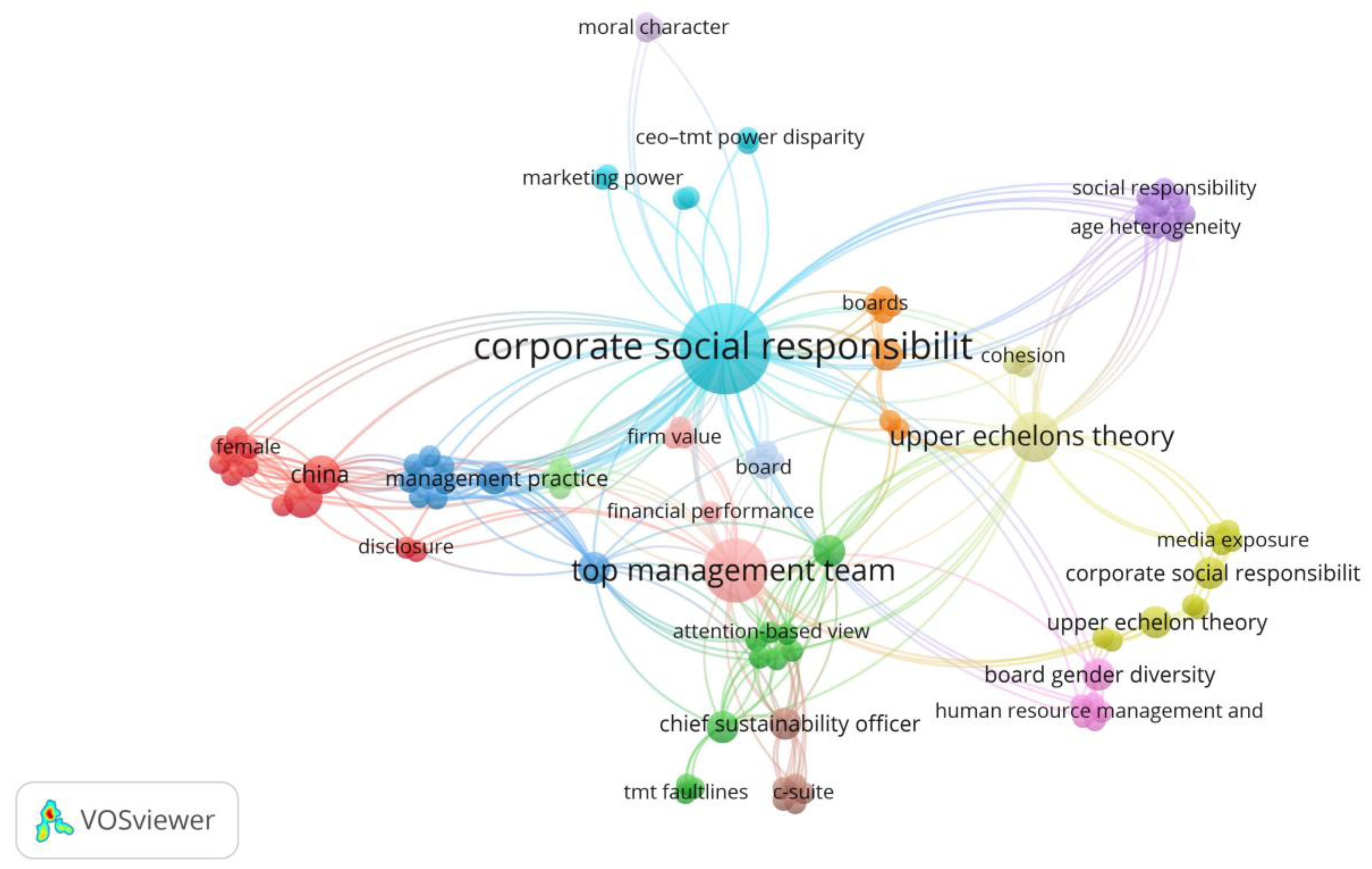
| Criteria | Interpretation of Criteria | |
|---|---|---|
| Inclusion | Closely associated | Academic articles that provide in-depth explanations of topic being studied. |
| Certainly associated | Few academic articles are included without detailed explanations. | |
| Exclusion | Non associated | This topic is not associated with its description. |
| Tangentially associated | The literature does not include any information or barely any information relating to this topic. The topic is only mentioned in passing and is not given primary attention. | |
| Lack of full-text | Authors of study lacked accessibility to whole content. |
| Study | Independent Variable (IV) | Dependent Variable (DV) | Moderating/ Mediating Factors | Sample/Context | Key Findings |
|---|---|---|---|---|---|
| [16] | TMT age and tenure heterogeneities | Firm risk | CSR (Moderator) | Non-financial listed companies (Malaysia) | TMT heterogeneity positively moderates CSR’s impact on firm risk |
| [17] | Board and TMT gender diversity | CSR | CSR (Mediator) | 248 for-profit organizations in Australia | Gender diversity correlates positively with CSR, improving organizational efficiency and employee productivity |
| [18] | Financial experts on TMT | CSR | - | Chinese enterprises | Financial experience benefits CSR, especially in non-state-owned firms |
| [19] | TMT gender diversity | Environmental standards adoption | Gender parity, executive power, CSR committees | 490 firms (China, India, Pakistan) | Positive relation between TMT diversity and ISO 14001 adoption |
| [20] | TMT media exposure | CSR | TMT power, political connections | 5352 firms (2010–2019) | Media exposure promotes CSR, but TMT power negatively moderates the effect |
| [21] | Management Position in TMT | Corporate Social Irresponsibility (CSI) and CSR | Firm size, firm age, service intensity, resource slack | 1569 businesses (63 sectors) | MP positively influences CSR, complemented by other aspects of CSI and CSR competency |
| [22] | Female managers in TMT | CSR performance | - | Manufacturing SMEs (201–2015) | Nonfamily SMEs outperform family firms in CSR, linked to female managers in TMT |
| [23] | TMT industrial and functional experience | CSP | TMT faultlines (Moderator) | 212 high-polluting Chinese enterprises | Functional experience heterogeneity has an inverted U-shaped impact on CSR and CSP |
| [6] | stability of TMT | CSR | CEO power | China’s publicly traded companies from 2009 to 2017 | TMT stability has a favourable impact on sustainable CSR. |
| [24] | TMT stability | CSR performance | Aspiration gap, slack resources | Chinese listed corporations (2010–2019) | TMT stability positively impacts CSR; moderated by aspiration gap and slack resources |
| [25] | Teacher occurrence in TMT | CSR scores and ranks | TMT and firm-level controls | Chinese A-share listed businesses | Teacher presence in TMT positively affects CSR scores and ranks |
| [26] | CSR efforts | Shareholder perceptions of TMT | CSR industry norms (Moderator) | S&P 1500 firms, shareholder simulations | CSR efforts shape perceptions of TMT’s moral character and remuneration acceptance |
| [27] | TMT composition | Firm performance | GHG emission strategy (Mediator), Organizational slack (Moderator) | Taiwanese public companies | TMT tenure and educational background heterogeneity negatively affect firm performance |
| [28] | Gender diversity of TMT | CSR | Marketization level (Moderator) | 17,032 manager-year observations from Chinese firms | Negative relation between CSR and female managers, moderated positively by marketization level |
| [29] | Managerial entrenchment | CSR | Women in TMT (Moderator) | 300 UK listed firms (2005–2017) | Positive correlation between managerial entrenchment and CSR, moderated by women in TMT |
| [30] | TMT and CEO considerations | CSP | CSR reporting (Mediator) | Publicly traded firms with CSR reports | CSR reports mediate the reduction of corporate social irresponsibility (CSI) |
| [31] | Chief Sustainability Officer (CSO) in TMT | Corporate social performance (CSP) | - | S&P 500 companies (2005–2014) | Presence of CSO improves CSR performance and reduces CSiR |
| [32] | TMT career development | CSR | Firm ownership (Moderator) | Chinese manufacturing enterprises | TMT’s international experience and educational background are linked to CSR success |
| [33] | TMT tenure | Firm employee CSR | - | U.S. airlines (1998–2013) | Inverse U-shaped relation between TMT tenure and employee-related CSR |
| [34] | CEO or TMT experience | CSR (environment, community, product, employee relations, diversity) | TMT and CEO-level controls | 100 U.S. industrial machinery companies (1998–2008) | TMT output experience complements CEO experience, with no impact on environmental CSR |
| [35] | TMT age heterogeneity | CSR | TMT interaction and education (Moderator) | Chinese listed companies (2008–2012) | Inverse U-shaped relation between CSR and TMT age heterogeneity, moderated by TMT interaction but not education |
| [36] | Chief officer of CSR | TMT impact on firm performance | - | U.S. listed businesses | Hiring a CSR chief officer improves financial performance, especially if female |
| [37] | Women in TMT | CSR disclosure | - | 88 Indonesian banks | Female executives positively influence CSR disclosure |
| [38] | TMT age, tenure, education, stock options | CSR | - | U.S. airlines (1998–2013) | Age and stock options are crucial for CSR, with stock options having a negative impact |
| [39] | Board and TMT composition, ownership | CSP | Firm size (Control) | 471 Chinese firms | Positive relation between board/TMT composition and CSR performance |
| [40] | TMT process | Firm performance (FP) | CSR (Mediator) | 203 lodging firms in Southeast China | TMT process and CSR mediate the positive link between TMT process and firm performance |
| [41] | TMT position | CSR | 85 companies from the US and Scandinavia | CSR TMT positions are more common in Scandinavian companies than in US organizations. | |
| [42] | Board gender diversity and foreign ownership | CSR performance | Interaction of gender diversity and foreign ownership (Moderator) | Chinese listed firms and stock exchange databases, CSR reports | Board gender diversity and foreign ownership both positively impact CSR performance. |
| Topic | Findings | Citations |
|---|---|---|
| Diversity in TMT and CSR | Studies suggest a positive correlation between gender diversity in TMT and CSR outcomes, indicating that diverse perspectives in leadership contribute to better CSR performance. | [22,42] |
| Media Exposure and CSR | TMT media exposure positively influences CSR initiatives, moderated by TMT power and political connections, highlighting the importance of strategic communication in CSR. | [20] |
| Educational Background and CSR Performance | Educational background heterogeneity in TMT may negatively impact CSR and business performance, indicating a need for a balanced mix of educational backgrounds for effective CSR strategies. | [35] |
| TMT Stability and CSR | TMT stability is associated with sustainable CSR practices, with stable TMTs contributing positively to CSR performance, emphasizing the importance of consistent leadership in shaping corporate responsibility. | [6,24] |
| Role of Chief Sustainability Officer (CSO) | The presence of a CSO in TMT is linked to higher CSR and reduced corporate social irresponsibility, underscoring the strategic role of dedicated sustainability leadership in shaping CSR outcomes. | [31] |
| Impact of Functional Background in TMT | The functional background of TMT members plays a crucial role in shaping various aspects of CSR, such as community relations and employee diversity, with diverse functional expertise contributing to a comprehensive CSR strategy. | [34] |
| Influence of Ownership and Financial Expertise | The ownership structure of a company can modify the connection between TMT characteristics and CSR efforts, with financial expertise in TMT being particularly beneficial for CSR in non-state-owned and cash-rich organizations. | [18,32] |
| TMT Tenure and CSR | TMT tenure has an inverse U-shaped association with CSR, where moderate tenure is associated with positive CSR outcomes, while extremes in tenure may hinder CSR efforts. | [33,38] |
| Global Context Matters | Regional differences are evident, emphasizing the importance of considering unique contexts of different countries when analyzing the relationship between TMT characteristics and CSR. | [37,38,41] |
| Role of CSR Reporting | CSR reporting serves as a crucial mediator in reducing the likelihood of corporate social irresponsibility, with companies with transparent CSR reporting mechanisms likely to demonstrate more responsible behavior. | [30] |
| TMT Gender Diversity Boosts CSR | Groundbreaking research establishes a positive association between TMT gender diversity and CSR outcomes. | [29] |
| TMT Heterogeneity and Firm Risk | CSR moderates the link between total TMT heterogeneity and firm systematic risk. | [16] |
| Financial Experience Influence | Senior executives’ financial experience positively impacts CSR. | [5,18] |
| Gap | Rationalization | |
|---|---|---|
| Personality Traits and CSR Influence | Limited exploration of how individual attributes, particularly personality traits within TMT members, influence CSR. | Understanding the interplay between individual-level characteristics and group decision-making can optimize TMT composition for enhanced CSR outcomes. |
| TMT Dynamics, Composition, and CSR Initiatives | Incomplete comprehension of how TMT dynamics, and composition (including expertise and ethnicity diversity), impact the development and application of CSR initiatives. | Further research is essential to unravel the nuanced ways in which diverse TMTs shape CSR strategies and decision-making processes. |
| CEO–TMT Relationship and CSR Impact | Limited exploration of the CEO–TMT relationship in the context of CSR efforts. | Investigating the impact of CEO–TMT interactions on CSR performance and sustainability initiatives can provide crucial insights into fundamental business dynamics. |
| Balancing CSR Objectives and Short-Term Profits | Scarcity of research on how TMTs navigate the balance between long-term CSR objectives and short-term profits. | Exploring how TMTs manage this dilemma can shed light on factors influencing CSR adoption within the challenging landscape of conflicting priorities. |
| TMTs Navigating Regulatory Shifts and Societal Standards | Limited analysis of how TMTs adapt to evolving CSR-related regulatory frameworks and societal standards. | Understanding how TMTs acquire new skills, share information, and modify CSR tactics over time is crucial for firms navigating a dynamic CSR landscape. |
| Cross-Cultural Dynamics in TMTs and CSR Practices | Insufficient exploration of how TMTs with diverse cultural backgrounds influence CSR performance and handle cross-cultural challenges in a global setting. | Recognizing the impact of cross-cultural variations on TMT roles and CSR practices is vital for businesses operating in diverse global environments. |
| TMT Performance Measures and CSR Accountability | Limited investigation into the impact of TMT performance measures and accountability systems on CSR outcomes. | Gaining insights into TMTs’ CSR performance evaluation and incentive systems can enhance the understanding of sustainability commitment within organizations. |
Disclaimer/Publisher’s Note: The statements, opinions and data contained in all publications are solely those of the individual author(s) and contributor(s) and not of MDPI and/or the editor(s). MDPI and/or the editor(s) disclaim responsibility for any injury to people or property resulting from any ideas, methods, instructions or products referred to in the content. |
© 2024 by the authors. Licensee MDPI, Basel, Switzerland. This article is an open access article distributed under the terms and conditions of the Creative Commons Attribution (CC BY) license (https://creativecommons.org/licenses/by/4.0/).
Share and Cite
Hąbek, P.; Saeed, F. Exploring the Relationship between Top Management Team Characteristics and Corporate Social Responsibility: A Literature Review and Bibliometric Analysis. Sustainability 2024, 16, 8563. https://doi.org/10.3390/su16198563
Hąbek P, Saeed F. Exploring the Relationship between Top Management Team Characteristics and Corporate Social Responsibility: A Literature Review and Bibliometric Analysis. Sustainability. 2024; 16(19):8563. https://doi.org/10.3390/su16198563
Chicago/Turabian StyleHąbek, Patrycja, and Fizza Saeed. 2024. "Exploring the Relationship between Top Management Team Characteristics and Corporate Social Responsibility: A Literature Review and Bibliometric Analysis" Sustainability 16, no. 19: 8563. https://doi.org/10.3390/su16198563
APA StyleHąbek, P., & Saeed, F. (2024). Exploring the Relationship between Top Management Team Characteristics and Corporate Social Responsibility: A Literature Review and Bibliometric Analysis. Sustainability, 16(19), 8563. https://doi.org/10.3390/su16198563










